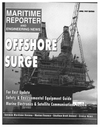
Page 91: of Maritime Reporter Magazine (April 1997)
Read this page in Pdf, Flash or Html5 edition of April 1997 Maritime Reporter Magazine
EUROPEAN UPDATE
Belgians Scoop Up doing Contracts by Carol Fulferd & Andy Smith
Straddling theNhorder between Belgium and the Netherlands, the massive delta formed where theSJlivers Maas, Waal and Scheldt meandeiNnto the North Sea constitutes the seawarayend of a busy inland waterway network whicir^ncludes the
River Rhine. To maintain the smooth running of high volumes of commercial traffic^ both nations have, over many years, built up Simer- tise in the design and operation of dredgers?*
Dredging International (DI), from its base irN
Antwerp, Belgium, is one company which has secured a number of major capital and mainte- nance dredging contracts around the world, thus confirming the preeminence of the so- called Low Countries in this particular field.
The company has become a dominant force in the Far East with extensive activity in
Malaysia, Taiwan, Indonesia, Vietnam and
Australia, and has ongoing projects in North
Africa, South America and the Caribbean.
A significant boost for DI's Asia-Pacific Group came in mid-1996 with the award of a new con- tract at Port Klang, Malaysia, which involved deepening the five-mile long and 1,300-ft. (400- m) wide access channel. The task at this busy container port located 25 miles west of Kuala
Lumpur involved the removal of six million cu. m. of material to a dump zone positioned approximately 10 miles offshore. The latest generation of containerships will now be able to i call at the Port.
Pearl River, reportedly the world's largj^t
This unconventional Dutch RoRo design is from Schelde Shipbuilding trailing suction hopper dredger with a capacity of 17,000 cu. m., was deployed for the project, while continuing to alternate between other jobs including the reclamation of 500 acres for a residential area and marina off Port Klang, and a reclamation project at Ancol Barat in the Bay of Jakarta. Pearl River is currently committed to a four-year maintenance dredging contact at the large LNG and general carg^port at
Bintulu, Sarawak.
Last July, Far East Dredging, a^DPWai Kee ings joint venture, hegscydredging the accefVchannel to the Taiwaj^se Port of Tan
Shui. Dtedgers Cap Martin And. River Bee were employed ?ior this three jnillion-cu.-m. dredge and fill operation, whiyn posed a number of challenges, including^mpredictable weather and sea conditioSe/ind the requirement to dovetail dredging opa^tions with the construc- tion of sea and qray wai^s.
At the sam^time, cutoter suction dredger
Rubens was deepening a sixNcile long seaward access chamel at the Vietnamese Port of Hon
Chong to jprovide a local eementxprks with a more efficient transport option.
In O^ober, DI will take over the sec9^d part of aXwo-year contract at the Port of Cochin,
Indffa, from joint venture partner Van OOT cifique, a 430-ft. (131-m) trailing suction hop- er dredger, will prevent the silting up of one of
India's West Coast harbors and its access chan- nel by removing 19 million cu. m. of mud.
DI will also soon begin clearing Martin Garcia
Channel in the Rio de la
Plata, Uruguay. Valued at $180 million over a 10- year period, the project involves removal of 35 million cu. m. of material and will open up a num- ber of Uruguayan and
Argentinian ports.
Cutter suction dredger
Amazone will undertake the lion's share of the work in the more difficult northern part of the channel where the sea bottom comprises firm
N ; 1P* ' 1 »r. clay alia rock. sewhere in the world, DI teams are current-
Involved in reclamation work on Guadaloupe,
Maintenance dredging at five Tunisian ports and flood protection work in Brisbane,
Australia. In Belgium, the company is involved in connecting Antwerp's second container ter- minal to the national and pan-European rail network with a land consolidation scheme. The rail link will eventually pass over a 20 to 26-ft. (6 to 8-m) layer of material dredged from
Antwerp Harbour. Other local projects include erosion protection work on the River Scheldt and the construction of a new ferry terminal at the Port of Ostend.
New hybrid tug design
Holyhead Towing has recently taken delivery of a multi-purpose tug designed by the compa- ny's managing director, Capt. Mark Meade.
Dubbed Afon Goch, the vessel's design is an attempt to combine the performance and sea- handling of a conventional twin-screw tug with the large open deck space of the Multicat style workboat.
In 1995, the company built a vessel at its own yard which broadly copied the Multicat concept made popular by Dutch builder Damen. lolyhead's version, Llandwyn Island, has a ft. x 25.6-ft. (21.5 m x 7.8-m) hull, is com- ple£^v rectangular in plan and features a raisedN^eckhouse offset tight against the port gunwale\The vessel has an enormous deck area, although its square bow is less than ideal for offshore coalitions.
The design ioS^s were taken to Hepworth
Shipyard in Hull aWl a build contract was nego- tiated. Capt. MeadKrefers to Afon Goch as a
Multitug, and the vessel resembles a conven- tional 78-ft. (23.8-m), tNtin-screw tug with a beam of 24.6 ft. (7.5 m). AVnall octagonal tug- style pilothouse is located neSyr the vessel's cen- terline and there is a clearly defined bow. Twin exhaust stacks are angled to maximize visibili- ty. Closer inspection reveals harcNvood covered working decks with both anchor handling and towing winches located amidships in a tunnel formed beneath the pilothouse.
The vessel's conventional propulsion system
April, 1997 91

 90
90

 92
92
